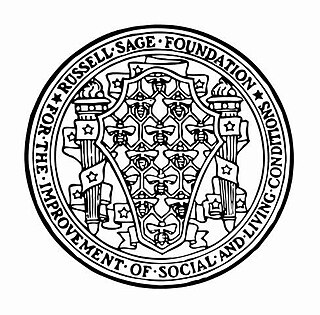Related Research Articles

Greasers are a youth subculture that emerged in the 1950s and early 1960s from predominantly working class and lower-class teenagers and young adults in the United States and Canada. The subculture remained prominent into the mid-1960s and was particularly embraced by certain ethnic groups in urban areas, particularly Italian Americans and Hispanic Americans.

The Russell Sage Foundation is an American non-profit organisation established by Margaret Olivia Sage in 1907 for “the improvement of social and living conditions in the United States.” It was named after her recently deceased husband, railroad executive Russell Sage. The foundation dedicates itself to strengthening the methods, data, and theoretical core of the social sciences in order to better understand societal problems and develop informed responses. It supports visiting scholars in residence and publishes books and a journal under its own imprint. It also funds researchers at other institutions and supports programs intended to develop new generations of social scientists. The foundation focuses on labor markets, immigration and ethnicity, and social inequality in the United States, as well as behavioral economics.

Stereotypes of Hispanic and Latino Americans in the United States are general representations of Americans considered to be of Hispanic and Latino ancestry or immigrants to the United States from Spain or Latin America, often exhibited in negative caricatures or terms. Latin America is generally considered to comprise all of the politically independent territory of the Western Hemisphere other than Canada and the United States that was originally colonized by the Spaniards or Portuguese. "Latino" is the umbrella term for people of Latin American descent that in recent years has supplanted the more imprecise and bureaucratic designation "Hispanic." Part of the mystery and the difficulty of comprehension lie in the fact that the territory called Latin America is not homogeneous in nature or culture. Latin American stereotypes have the greatest impact on public perceptions, and Latin Americans were the most negatively rated on several characteristics. Americans' perceptions of the characteristics of Latin American immigrants are often linked to their beliefs about the impact of immigration on unemployment, schools, and crime.
Latino Americans have received a growing share of the national vote in the United States due to their increasing population. As of the 2020 U.S. Census, 62.1 million Latinos live in the United States, representing 18.9% of the total U.S. population. This is a 23% increase since 2010. This racial/ethnic group is the second largest after non-Hispanic whites in the U.S. In 2020, the states with the highest Hispanic or Latino populations were; Arizona, California, Florida, Illinois, Nevada, New Jersey, New Mexico, New York, and Texas. According to the Brookings Institution, Latinos will become the nations largest minority by 2045 and the deciding population in future elections. With the help of laws and court case wins, Latinos have been able to receive the help needed to participate in American Politics. According to data provided by The Collaborative Multiracial Post-Election Survey (CMPS), 72% of Latinos believe that it is very/somewhat important to get their voice heard by voting. They have traditionally been a key Democratic Party constituency, but more recently have begun to split between the Democratic and Republican Party. Since the Latino population is large and diverse, a lot of political differences exist between gender, national origin, and generational groups.
In the United States, a Hispanic or Latino is an individual who is of full or partial Hispanic or Latino descent. Although not differentiated in the U.S. Census definition, White Latino Americans may also be defined to include those who identify as white and either originate from or have descent from not only Spanish speaking countries in Latin America but also other Romance languages other than Spanish, such as Brazil, Haiti, and French Guiana.
Victoria Hattam is an Australian-born American political scientist, noted for her research on American political economy and political development, and on the role of class, race and ethnicity in American politics.
The Latino National Survey (LNS) contains 8,634 completed interviews (unweighted) of self-identified Latino residents of the United States. Interviewing began on November 17, 2005, and continued through August 4, 2006. The survey instrument contained approximately 165 distinct items ranging from demographic descriptions to political attitudes and policy preferences, as well as a variety of social indicators and experiences. All interviewers were bilingual, English and Spanish. Respondents were greeted in both languages and were immediately offered the opportunity to interview in either language. Interviewers also provided a consent script that allowed respondents to opt out of the survey. Demographic variables include age, ancestry, birthplace, education level, ethnicity, marital status, military service, number of people in the household, number of children under the age of 18 living in the household, political party affiliation, political ideology, religiosity, religious preference, race, and sex.
Mary C. Waters is an American sociologist and author. She is a professor at Harvard University.
Philip Kasinitz is an American sociologist. He is currently a Presidential Professor of Sociology at the CUNY Graduate Center where he has chaired the doctoral program in Sociology since 2001.
Rubén G. Rumbaut is a prominent Cuban-American sociologist and a leading expert on immigration and refugee resettlement in the United States. He is Distinguished Professor of Sociology at the University of California, Irvine.
The City of Los Angeles includes a prominent Central American population. As of 2010 it is the second largest Latino and Hispanic ethnic group in Los Angeles after Mexican-Americans. The largest Central American groups were Guatemalans, Hondurans and Salvadorans.

Mexican Americans have lived in Los Angeles since the original Pobladores, the 44 original settlers and 4 soldiers who founded the city in 1781. People of Mexican descent make up 31.9% of Los Angeles residents, and 32% of Los Angeles County residents.
This is a Mexican American bibliography. This list consists of books, and journal articles, about Mexican Americans, Chicanos, and their history and culture. The list includes works of literature whose subject matter is significantly about Mexican Americans and the Chicano/a experience. This list does not include works by Mexican American writers which do not address the topic, such as science texts by Mexican American writers.

There is a very large Mexican American community in the Chicago metropolitan area. Illinois, and Chicago's Mexican American community is the largest outside of the Western United States.
The following is a list of works about Boston, Massachusetts.
Hometown associations (HTAs), also known as hometown societies, are social alliances that are formed among immigrants from the same city or region of origin. Their purpose is to maintain connections with and provide mutual aid to immigrants from a shared place of origin. They may also aim to produce a new sense of transnational community and identity rooted in the migrants' country of origin, extending to the country of settlement. People from a variety of places have formed these associations in several countries, serving a range of purposes.
Jennifer Lucy Hochschild is an American political scientist. She serves as the Henry LaBarre Jayne Professor of Government, Professor of African and African American Studies and Harvard College Professor at Harvard University. She is also a member of the faculty at Harvard's Graduate School of Education and John F. Kennedy School of Government.
Melissa R. Michelson is an American political scientist. She is a professor of political science at Menlo College, and in July 2020 she became the Dean of Arts and Sciences there. She studies voter mobilization and engagement in the United States, particularly among minority communities, as well as public opinion and political communication.
Donna Rae Gabaccia is an American historian who studies international migration, with an emphasis on cultural exchange, such as food and from a gendered perspective. From 2003 to 2005 she was the Andrew Mellon Professor of History at the University of Pittsburgh and from 2005 to 2012 she held the Rudolph J. Vecoli Chair of Immigration History at the University of Minnesota. During the same period, she was the director of the Immigration History Research Center at the University of Minnesota. In 2013, her book, Foreign Relations: Global Perspectives on American Immigration won the Immigration and Ethnic History Society's Theodore Saloutos Prize in 2013.
Mary Fainsod Katzenstein is an American political scientist. She is the Stephen and Evalyn Milman Professor of American Studies, Emerita at Cornell University. She specializes in prison reform in the United States, the history of American feminist activism, and the politics of India.
References
- ↑ "Michael Jones-Correa | Political Science Department". www.sas.upenn.edu. Retrieved 2021-03-14.
- ↑ "Michael Jones-Correa: President's Distinguished Professor". almanac.upenn.edu. Retrieved 2021-03-14.
- ↑ Holding Fast: Latino Immigrant Civic Engagement and Resilience in Polarizing Times. New York, New York: Russell Sage Foundation Press. 2020-10-08. ISBN 9780871545695.
- ↑ Outsiders No More?: Models of Immigrant Political Incorporation. Oxford, New York: Oxford University Press. 2013-07-31. ISBN 9780199311316.
- ↑ Hero, Rodney E. (December 2014). "Outsiders No More? Models of Immigrant Political Incorporation. Edited by Jennifer Hochschild, Jacqueline Chattopadhyay, Claudine Gay, and Michael Jones-Correa. New York: Oxford University Press, 2013. 305p. $99.00 cloth, $39.95 paper". Perspectives on Politics. 12 (4): 916–917. doi:10.1017/S1537592714002370. ISSN 1537-5927. S2CID 143508735.
- ↑ "Latinos new millennium almanac opinion behavior and policy preferences | American government, politics and policy". Cambridge University Press. Retrieved 2018-07-26.
- ↑ Wong, Janelle (September 2013). "Latinos in the New Millennium: An Almanac of Opinion, Behavior, and Policy Preferences. By Luis R. Fraga, John A. Garcia, Rodney E. Hero, Michael Jones-Correa, Valerie Martinez-Ebers, and Gary M. Segura. New York: Cambridge University Press, 2011. 448p. $99.00 cloth, $36.99 paper". Perspectives on Politics. 11 (3): 947–949. doi:10.1017/S153759271300162X. ISSN 1537-5927.
- ↑ Fraga, Luis; Garcia, John A.; Hero, Rodney; Jones-Correa, Michael; Segura, Gary M. (2010-01-28). Latino Lives in America: Making It Home. Philadelphia, Pa: Temple University Press. ISBN 9781439900499.
- ↑ Rocha, Rene R. (December 2011). "Latino Lives in America: Making it Home. By Luis Ricardo Fraga, John A. Garcia, Rodney E. Hero, Michael Jones-Correa, Valerie Martinez-Ebers, and Gary M. Segura. Philadelphia: Temple University Press. 2010. 224p. $76.50 cloth, $26.95 paper. - ¡Marcha!: Latino Chicago and the Immigrant Rights Movement. Edited by Amalia Pallares and Nilda Flores-González. Urbana: University of Illinois Press, 2010. 320p. $85.00 cloth, $30.00 paper". Perspectives on Politics. 9 (4): 911–913. doi:10.1017/S1537592711003239. ISSN 1541-0986.
- ↑ Jones-Correa, Michael, ed. (2005-03-24). Governing American Cities: Inter-Ethnic Coalitions, Competition, and Conflict. New York: Russell Sage Foundation. ISBN 9780871544179.
- ↑ van den Berg, Marguerite; Rusinovic, Katja (June 2007). "Reshaping the American mainstream: immigrants? influence on American culture and inequalities". International Journal of Urban and Regional Research. 31 (2): 489–494. doi: 10.1111/j.1468-2427.2007.00735.x . ISSN 0309-1317.
- ↑ results, search (1998-06-04). Between Two Nations: The Political Predicament of Latinos in New York City (1 ed.). Ithaca: Cornell University Press. ISBN 9780801483646.
- ↑ DeSipio, Louis (1999). "Between Two Nations: The Political Predicament of Latinos in New York City by Michael Jones-Correa". Political Science Quarterly. 114: 332–333. doi:10.2307/2657758. JSTOR 2657758.